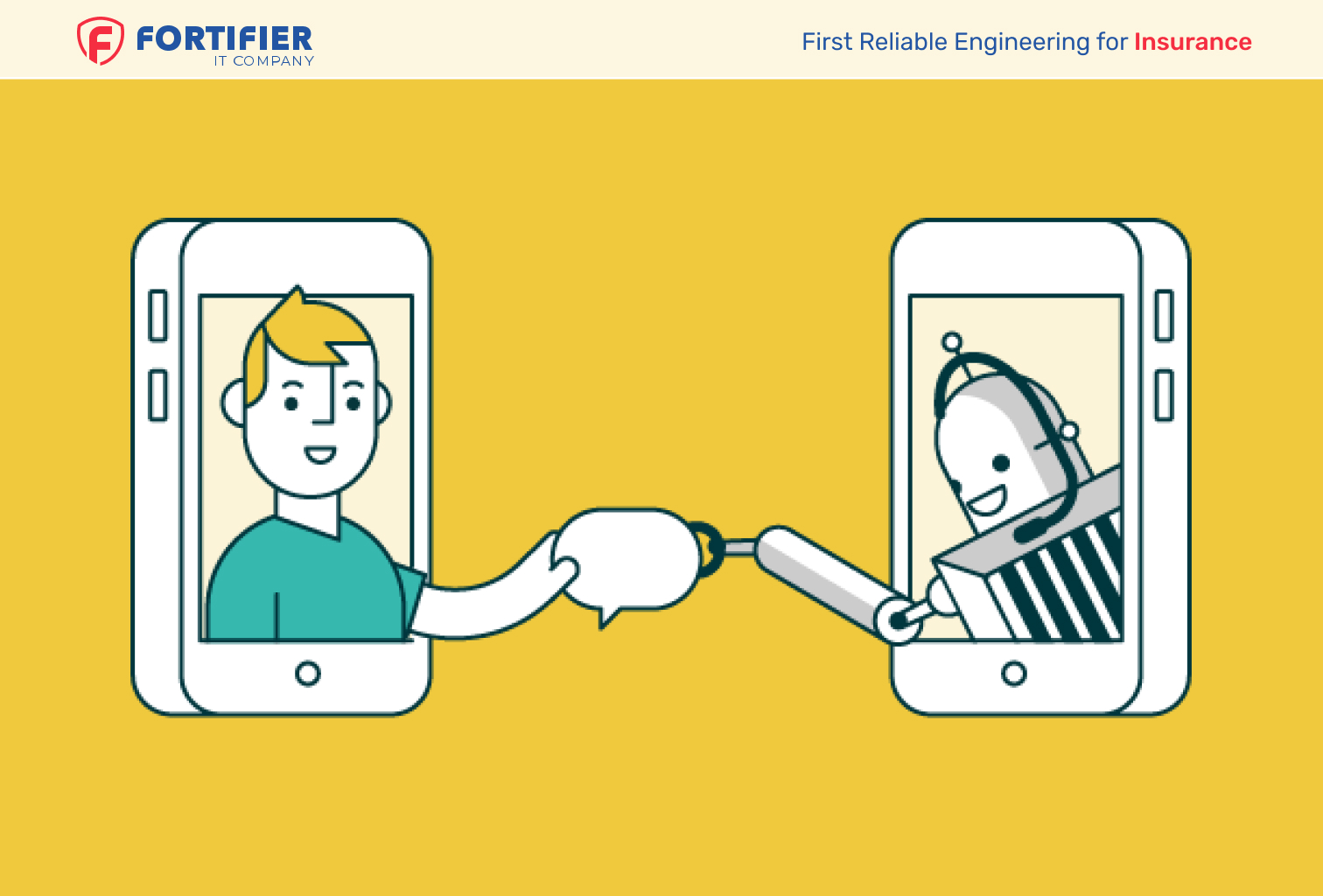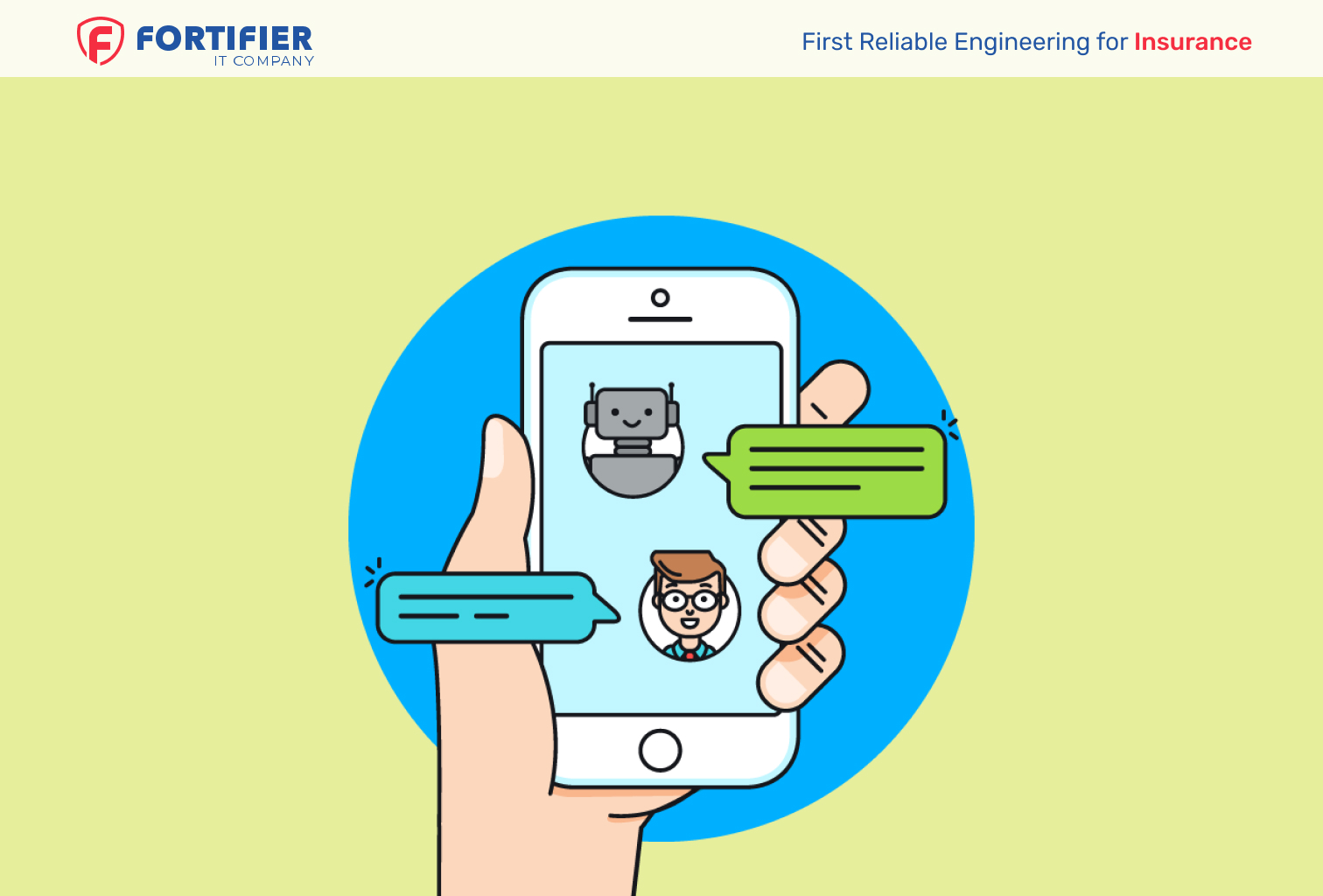A chatbot is a highly-intelligent application that, similarly to a live human, can communicate with other real people with text messages.
During the past few years, the market’s best insurance agency management systems with the chatbot functionality have been most actively implemented by insurance companies striving to enhance the quality of customer support. Thus, instead of hiring a whole department of insurance agents dedicated to processing customer requests, calculating their insurance costs, and doing other monotonous tasks, a company can use a chatbot. They specialize in template answers, having a complete database of them at hand (moreover, they can provide answers generated by artificial intelligence on the go). Let’s talk more about this exciting type of advanced software and its capabilities for a progressive agency management system.

Types of chatbots
Generally speaking, there can be 2 separate types of chatbots used, depending on a particular user’s needs:
- all-purpose, AI-based chatbots (able to answer the widest range of questions; the most advanced solutions can successfully replace human insurance agents and are, usually, integrated with ready-made CRM systems and Claim Management systems);
- pre-programmed, algorithm-based chatbots (the most primitive level of chatbot capabilities; such solutions can be implemented even by a beginner insurance software developer; we’ll discuss this in more detail below).
If we take the insurance business, in particular, here, dedicated software solutions play a priceless part in customer service (Can you even imagine how many requests an average insurance company processes daily?!).
How does a chatbot work?
To interact with users and imitate human behavior, chatbots use either common messenger platforms, such as Facebook, Messenger, Slack, Telegram, or Viber, or custom developed platforms configured to meet the demands of a particular TA. As for the mechanism of supporting a dialogue, various chatbots can be based on rules (i.e., work according to the predefined parameters by the developers’ algorithm, similarly to most other types of software) or employ machine learning capabilities and/or artificial intelligence (AI).
The latter is quite complex in realization, but it makes chatbots susceptible to the extensively wide range of tasks (developers don’t need to work through each and every variant of responses to user requests, self-learning mechanisms handle most of the work).
The chatbots based on rules predefined by the developers (the first generation of chatbots) work by the similar principles as any other automated user interaction systems (e.g., Smart IP telephony systems). They simply provide users with the selection of several options (“push ‘1’ to transfer money”; ‘2’ – to view balance; ‘3’ – something else, etc.).

As for AI-based chatbots, they can provide a pretty realistic level of communication (Siri is a great example) due to an ability to imitate the self-learning process each time a chatbot interacts with a human. Thus, intelligent bots are able to kind of store their past practical experiences and “guess” some of the users’ intentions and desires, providing a productive and useful dialogue. Moreover, the capabilities of AI-based chatbots provided by the best p&c insurance software vendors are gradually expanded, and the interaction experience is being enhanced due to the development of IT branches such as Natural Language Processing, which is focused on the recognition of context in human speech.
Prospects of implementing chatbots for automated workflows
As you might already understand, in the insurance business, chatbots are able to solve one very serious issue—they can provide the efficient means of interaction with customers (customer support) without the necessity to establish a full-blown call-center. An entirely separate department housing numerous highly-qualified insurance agents (picture how much money you would need in order to provide new workspaces, handle all the necessary taxes, and be able to offer a competitive salary). Surely, you’ll still need several operators who would be responsible for non-trivial questions or communicate with customers because they specifically would like to contact a live human being. Nevertheless, the intelligent software allows for much less expense.
Thus, we can conclude that automated insurance agents can be a real remedy for average- and large-scale insurance businesses. The thing is, good customer service and employment of insurtech developments are nearly all that’s left that can help companies stay competitive in the market filled to the brim with insurance offers. And according to practice, companies that successfully implement chatbots establish customer support with a much higher level of performance as compared with all-human customer support solutions (at least because a single chatbot can simultaneously interact with thousands of customers).
Case study of insurance product development software
By the following link, you can see our take on the insurance product development software. This solution was created for the Fortifier’s client’s project to increase insurance agents’ productivity by delivering the relevant content to customers.
In particular, the automation of processes related to the request processing allows one agent to interact with several customers simultaneously without the necessity to work more intensely. Now, business owners shouldn’t worry—customer communication and answers to trivial questions can be almost completely made a responsibility of a smart assistant. Meanwhile, the insurance agents from the staff will be able to take a break from routine responsibilities and get to work on documentation, reviewing insurance cases, and other tasks that require a consistent approach.
In such a way, our option of insurance agency software is a perfect solution to an insurance company’s scaling issue concerning the necessity to cut expenses as much as possible. No new employees, no need to rent additional office space—this chatbot helps agents single-handedly cope with the extreme flow of customers.
Implementing an insurance agency management system: summary

In this article, we learned what a chatbot is and which issues the implementation of an automated insurance agency management system in the existing functionality can help solve better than a human. In particular, this insurance software allows realizing the following tasks without the direct participation of live insurance agents in a dialogue with customers:
- processing of requests;
- fast search for the nearest office;
- processing of complaints;
- immediate insurance notifications;
- automatic calculations.
The implementation of the dedicated agent insurance software leads to an increase in the level of sales and customer rates.
If you are also interested in the creation of a chatbot for your own insurance company and are currently traveling through search engines with a request like Software Developer Insurance, we will do the top-notch job for you! Our team has solid experience in the development of these solutions, and we’ll provide an intelligent, powerful-in-performance, and budget-savvy solution for your particular case.


